Tour of Turkey
| ANZAC Memorial and Museum | 40 12 26.18N 26 16 54.12E | The memorial overlooks ANZAC Cove and the scenes of some of the fiercest fighting on the Gallipoli Peninsula. |
| Troy | 39 57 26.29N 26 14 21.44E | The outline of walls and buildings can be clearly seen. The large white shape is a temporary cover over excavations. |
| Pergamon | 39 07 58.51N 27 11 01.70E | Note particularly the Temple of Trajan on the summit of the hill and the steeply sloping theatre. |
| Asklepion | 39 07 07.90N 27 09 55.90E | Note the theatre. The round building in the opposite corner is where the "dream healing" ritual took place. |
| Ephesus | 37 56 27.64N 27 20 33.06E | The coordinates are for the great theatre in Ephesus. |
| Pamukkale | 37 55 27.75N 29 07 27.83E | The white terraces of Hierapolis can be seen from all over the valley. Laodicea is a short distance to the south. |
| Colossae | 37 47 12.54N 29 15 36.63E | Few tourists make it to Colossae, but the outline of the theatre can be clearly seen on the east side of the tel. |
After our tour and dig concluded in Israel, about half of the group stayed for an extra week for our optional tour of Turkey. We flew from Tel Aviv to Istanbul where we stayed in a unique hotel in the oldest part of the city. The hotel consists of a row of 19th century terrace houses, once the residences of wealthy citizens. The picturesque wooden villas have been converted into tourist accommodation with period furniture and antique Turkish decor. We ate exquisite meals in a glass-roofed restaurant overlooking the hotel garden and enjoyed the quaint atmosphere. An added benefit was that we were within walking distance of all the major sites of the city.
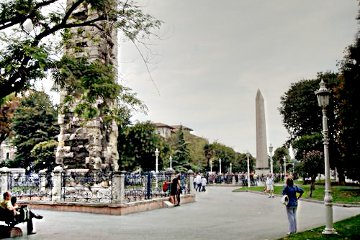
| |
| The Hippodrome with its obelisks is in the heart of old Byzantium. |
We reached our hotel just around mid-morning, so after leaving our luggage in our rooms we strolled along a narrow lane through a jumble of old buildings and emerged into a large open space - the old hippodrome. Today suicidal taxis race where the old horse teams used to compete, for the modern streets follow the outline of Constantine's hippodrome.
The racecourse was 1,560 feet long and 380 feet wide. 60,000 spectators could sit on either side, on stone seats supported by massive brick vaults. Down the centre of the hippodrome was a long, low wall known as the spina, on which were placed columns, statues and obelisks and the all-important dolphins and balls which indicated how many laps had been run. The chariot teams wore colours, red, white, blue and green and the crowd dressed in the colours of the teams they supported or sported outlandish haircuts in imitation of their favourite charioteer.
Today the seating has vanished, but three objects brought to beautify the spina still remain: the first is an obelisk of Tutmoses III on which hieroglyphics declare, "Thutmosis, who crossed the great river of Nahrain [Euphrates] as a mighty conqueror at the head of his army." The second is another obelisk built of blocks of stone. Originally it was covered in bronze plates which were probably decorated and inscribed, but they were stolen when the city was looted during the Fourth Crusade.
The third object is probably the most interesting, for it is a column made of three bronze serpents twining around each other. Today it ends in a jagged stump, but originally the heads othe serpents spread out to form the base for a golden tripod set up by the Plateans in thankfulness for their victory over the Persians. Sultan Mehmet Fatih, who conquered Byzantium, is said to have broken one of the heads with his iron mace as he rode into the city; the others were broken off by a drunken Polish diplomat in April 1700 after a night of drinking! One of the heads, minus its lower jaw, is in the Archaeological Museum but only rarely on display.
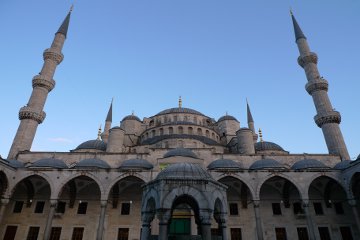
| |
| The exterior of the Sultan Ahmet Mosque, built in imitation of the nearby Hagha Sophia church. |
The hippodrome is dominated by two buildings; the first is the Sultan Ahmet Mosque, commissioned by Sultan Ahmet (1603-1617) when he was only 19 years old. He was so eager to see his mosque completed that he is said to have worked alongside the labourers. In a fit of bragadoccio he ordered that his mosque have six minarets - the same number as the Grand Mosque in Mecca. The mullahs made so much of a fuss about this that he sent his architect to Mecca to build a seventh minaret there, so retaining the superiority of Mecca and the symmetry of his plan!
The mosque is filled with beautiful blue light from 260 windows filled with coloured glass, which reflects off the 20,000 tiles that cover the walls of the prayer hall and galleries. As a sign of respect, visitors are required to remove their shoes, but as tourists follow a one-way route, in one door and out the other, you have to carry your shoes with you! There is no entrance price to the house of God, but burly men at the exit ensure that visitors contribute generously!
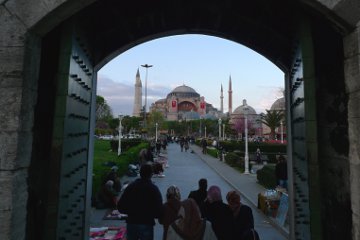
| |
| Haghia Sophia, framed by the doorway from the Sultan Ahmed Mosque. |
The other building is the Great Church of the Holy Wisdom, Haghia Sophia or, as the Turks call it, Aya Sofiya. The first church on the site was destroyed during the Nike Riots, when the mob in the hippodrome protested against the policies of the Emperor Justinian. Many buildings were set on fire, among them the church, and the riot was only quelled when Justinian's tough mercenaries massacred 30,000.
The building erected to replace it was the largest church in the world and, until the advent of modern concrete, it had the largest unsupported roof in the world, for the great dome, 101 feet in diameter, is supported not by hordes of pillars, but by a complex pattern of half-domes and walls. The church was so magnificent that it persuaded a delegation of Russians to adopt the Orthodox faith rather than Islam or Catholicism!
Directly in front of Haghia Sophia is another reminder of Istanbul's past - the huge underground cistern constructed by Justinian in AD 532. Later abandoned and lost, the inhabitants above had no idea of its existence, even though numerous city wells were sunk into it and the people had been using its water for centuries. A French traveller, Pierre Gilles, rediscovered the cistern in the 16th century. Rowing a small boat and lit by torchlight, he explored the cavernous interior whose roof is supported by 336 marble columns. Any visit to this dark, damp and dimly lit cavern is eerie: water drips from the roof, the wooden ramps and walkways are suspended over the underground lake, and hundreds of dimly-lit columns are reflected in the black water. The columns are a strange mixture of styles and shapes, since the majority were salvaged, or stolen, from ancient buildings and reused. Some of the columns are upside down and two are erected on bases portraying the head and face of Medusa. One face is upside down, the other on its side. The surreal atmosphere is made the more strange by the weird music played over the loudspeakers and the objects of modern art suspended over the water.
The Archaeological Museum is one of the world's great treasure houses of artefacts from the ancient Near East. My group spent several hours wandering through the galleries housing glazed brick reliefs of lions and sirrushes from the Ishtar Gate and ceremonial way in Babylon; statues and stelae from Assyria; hundreds of tablets and figurines from ancient Sumer and Nippur; and most significant of all, rooms filled with Hittite statues, altars, sphinxes and reliefs excavated in digs all over Turkey. The Hamath Stone bears one of the earliest examples of Hittite hieroglyphs ever discovered. Nearby is the cuneiform tablet on which is inscribed the peace treaty drawn up after the Battle of Kadesh between Rameses II of Egypt and Hatusilis III of the Hittites.
Around the gallery are orthostat reliefs - huge blocks of stone carved with various scenes including gods, chariots, kings, soldiers and servants. The stones formed the gates to temples and palaces. The amazing thing is that most of the objects we viewed came from the time of the later Hittite Empire, after the Hittites had supposedly been destroyed. Of course, this anomaly disappears with the adoption of a revised chronology that brings the end of the Hittite Empire forward from the traditional date of about 1200 BC down to the 8th century BC.
The building across the courtyard houses several impressive sarcophagi from Lebanon, including the "Alexander Sarcophagus" which depicts a battle between Alexander's soldiers and the Persians. However the best galleries are upstairs and on every previous visit to Istanbul, they have been closed. But for some inexplicable reason, this year the upper floors were open. One gallery houses a vast array of pottery and other items excavated from Troy. A famous cuneiform tablet in another case listed the methods used by the Hittites for training horses.
I was overjoyed to find that the top floor gallery was open. Here are kept such archaeological treasures as the inscription found in Jerusalem describing the construction of Hezekiah's tunnel, 700 years before Christ. Also on view was the famous Gezer Calendar, a fragment of limestone on which is the oldest example of Hebrew writing, from the time of King Solomon, about 950 BC. The tablet, probably a schoolboy's exercise, lists the seasons and what crops are planted in them. Other items in the museum included pottery, oil lamps, jugs, bowls and figurines from Megiddo, Gezer and Samaria, all dating from the Middle Bronze Age.

| |
| One of the rooms in the harem of the Topkapi Palace. |
We finished the afternoon by wandering through the vast Topkapi Palace, built after 1453 by the Turkish sultans on the site of the ancient acropolis of Constantinople. A rambling collection of sumptuous rooms built around five vast courtyards, the palace is now a museum of Islamic art and Turkish history featuring costumes and warfare, Chinese and Turkish ceramics, gold and silver regalia and lavish jewellery. Most of the objects date from the time of the sultans, but fabulous as the contents of the museums are, even more fabulous are the palace rooms themselves - state rooms, private rooms, the kitchens and bedrooms, audience chambers and religious buildings, stables and servant's quarters, as well as the famous harem. The latter consists of about 300 rooms of which only about 20 elaborately furnished and decorated rooms are open to the public.
The following day was a free day in Istanbul and many of the group spent the day wandering the streets of Istanbul, shopping at the Grand Bazaar or admiring the splendid view from the Galatea Bridge up the famous harbour called "The Golden Horn." Beyond was the Bosphorus, the shining strip of water that separates Europe (where Istanbul is built) from Asia. In the distance we could see the buildings on the other side of the Bosphorus near where Florence Nightingale worked at Scutari. I wandered off my own to see the Mosaic Museum where sections of the mosaic floor from the old Imperial palace of Justinian's time have been excavated and preserved under a rambling collection of steel and glass roofs. The mosaics show all kinds of animals and people from the 4th century AD and are a veritable encyclopaedia of the times.
South to the Seven Churches
Early next morning we set off along the northern shore of the Bosphorus for Gallipoli. This was an emotional place for the Australians in the group as they trod the beach of Anzac Cove and looked up at the impenetrable heights controlled by the Turks in 1915. Reliving the terrifying scenes, we explored the nearby trenches and foxholes covered by the low shrubs. We read the inscriptions on the graves of countless young Australian and New Zealand soldiers who died on these shores.
We crossed by ferry from Europe to Asia. At this point the strip of water is called "the Dardenelles" but was known in ancient times as "the Hellespont." This was where Xerxes crossed with his Persian troops to invade Greece. When storms threatened to wash away the 600 boats that formed a floating bridge across the water, he is said to have made chains to hold the Hellespont back and had the sea lashed with a whip 300 times to tame its turbulence. A century and a half later, Alexander the Great crossed the Hellespont the other way to attack Persia. As Alexander landed, he hurled his spear into the soil of Asia to claim the Persian dominions for himself.
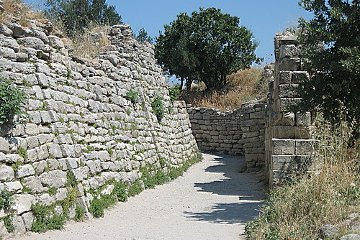
| |
| Are these the walls that kept the Greeks at bay for ten long years? |
We drove through Canakkale, a busy modern city, and came to Troy. Although little is left of the ancient city other than a few excavated walls, the sense of history is overpowering and the view from the top of the tel over the surrounding plains is superb. Those of our group who had watched the in-flight movie a few weeks earlier quickly populated the scene with the characters from Homer's classic story told in The Illiad. We wandered through the ruins, a confusing array of nine cities and 46 levels of occupation superimposed on each other, each exposed at different levels. Turkish archaeologists are convinced that Troy VI was the level at which the Trojan War took place, while American archaeologists argue that Troy VIIA was the city in which the wooden horse was dragged in. No one can be sure even now. A modern wooden horse built near the entrance gate of the city reminds all who come to Troy of the famous story of how the Greeks hid inside the horse and were dragged inside, to attack and capture the city from within.
From Troy it was a long drive beside the sparkling Aegean Sea to our superb hotel overlooking the harbour at Ayvalik. The next morning we left for Bergama, ancient Pergamon and one of the seven cities mentioned in the Book of Revelation as the location for a Christian church in the first century AD (Revelation chapters 2 and 3). The royal city of the Attalid kings was atop a small mountain overlooking the modern city.
Here are the ruins of the palaces of Philetaerus, Eumenes I, Attalus I, and Eumenes II and III, the kings who ruled western Asia Minor between 300 BC and 133 BC. The theatre seating 10,000 people was carved into the slope of the steep hill, while further around the hill was the most famous structure, the Altar of Zeus, now reconstructed in Berlin's Pergamon Museum. After the last Attalid king bequeathed his empire to Rome, the Romans erected several vast temples including one to the Emperor Trajan. Of particular interest was the ruined library of Pergamon that rivalled even the great library of Alexandria for the quantity and range of ancient scrolls it housed. Parchment, a writing material made from the skins of animals, was originally named "pergamene" after the city where it was invented in the second century BC.
On the plain below the acropolis was the Asclepion, a temple complex that included a gymnasium, sports ground, theatre and hospital to which the sick came from all over the ancient world. Named after the god Asclepios, depicted as snake, the priests gave their patients hallucinogenic drugs, made them bathe in a sacred spring and then led them through an underground tunnel to the basement of a temple. While the patients slept, they dreamed of the gods who, they believed, appeared to them and described what treatments were needed to cure them of their ailments. The treatment usually involved some kind of offering or payment, after which a cure could take place!
That afternoon we explored the centre of another of the cities of the "Seven Churches", known in ancient times as Smyrna and now called Izmir. Excavations of the agora began here many years ago, but in a new burst of enthusiasm the antiquities department has recommenced excavations and opened up new areas, exposing walls, underground bazaars and even the gate. It is planned that part of the agora will be restored with modern shops occupying the ancient buildings and selling the kinds of goods that were sold here 2,000 years ago.
The next day we explored Ephesus, the first of the Seven Churches listed in Revelation. Passing through the Magnesian Gate of the city, we walked along the marble paved streets lined with public bathhouses, civic buildings, temples to various gods and emperors, houses of the wealthy and the ruins of elaborate fountains. This was the city where the apostle Paul preached around AD 55-57. At one end of the street is the famous Library of Celsus, reconstructed from the fragments and now the most impressive sight at Ephesus. At the other end of the street is the theatre where the riot took place recorded in Acts chapter 19 when the citizens of the city gathered in protest against the preaching of Paul and chanted for two hours "Great is Diana of the Ephesians!"
The temple of Diana (known to the Greeks as Artemis) is a mile outside the walls of the ancient city. Once one of the "Seven Wonders of the World", hardly anything is left except a single marble column, reconstructed from the mangled bits of many other columns and erected in a swamp which was the site of the magnificent temple. In one of the great adventure stories of archaeology, John Turtle Wood identified the site in the mid-19th century. Undeterred by disease, the collapse of a trench, appalling food and accommodation, a broken collar-bone, an attempted assassination, and a murder, he continued his search for the temple. An inscription found in the theatre of Ephesus provided the vital clue: at the time of a performance, certain images were brought from the temple along the sacred way through the Magnesian Gate to the theatre. Starting from the gate, Wood located the sacred way and followed it back to the site of the temple.
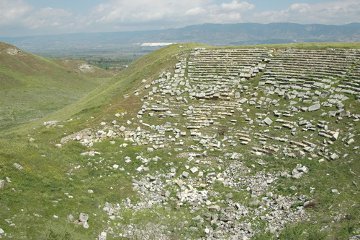
| |
| The seats in the main theatre in Laodicea are crumbling down the slope into which the theatre was dug. |
A three-hour bus journey, following the main highway west, brought us to the site of ancient Laodicea. On my previous visits to the site, my fingers itched to scratch away the dirt of this unexcavated tel. I was delighted to find an archaeological dig in full swing on the site. Already they have exposed a long stretch of marble paved street, the ruins of a monumental fountain, and most of the agora, or central square of the city.
With my group following me, we marched off across the grassy slopes and easily identified the outline of the unexcavated hippodrome, the lines of seats clearly visible in the grass. Not far away was the bathhouse, fed by water brought in by an arched aqueduct. One slope contained the clear outlines of the theatre, still in ruins. We stopped near the remains of a large church, possibly the one where the church council of the mid-4th century AD decreed that Christians should no longer observe the Sabbath on Saturday but should rather work on that day and honour the Lord's Day [Sunday] instead.
That night we stayed in a hotel near the thermal springs of Pamukkale, known in ancient times and in the New Testament as Hierapolis (Colossians 4:13). People have been coming to this city for thousands of years to bathe in the hot mineral water and they still do today. Our hotel was equipped with hot pools for bathing, and we saw more the next day as we explored the ancient city. The ruins included an impressive gate, a well-preserved theatre, extensive bathhouses, and the church built over the reputed tomb of St Philip, the evangelist in the book of Acts who baptised the Ethiopian eunuch (Acts 8:26-40).
Below the ancient city are the white travertine cliffs and terraces, basins and channels that make Pamukkale famous. Gleaming stalactites and crystalline formations, all made of natural salts, have been left behind by the evaporating hot water as it tumbles down into the valley below. The lukewarm water provided the inspiration for the message to the Christians in nearby Laodicea - their faith was like their water, lukewarm and insipid to taste.
The following day our bus took us over the mountains to Alasehir, the site of ancient Philadelphia. Little of the ancient city, mentioned in the book of Revelation, has been found, although a 4th century AD ruined church stands in the middle of the city. We photographed the scant remains and travelled on to Sart, the rather miserable village built on the site of ancient Sardis. Here there was more to see - the remains of the Roman road, the 3rd century AD synagogue and the large gymnasium and sports complex. Archaeologists who excavated the 4th century AD shops identified one as a paint shop belonging to Jacob, another was a hardware shop, while the shop of Sabbatios had a small private toilet. Another shop belonged to an elder of the nearby Jewish synagogue.
Crossing the modern highway (built over the ancient Roman road) we explored the ruined Temple of Artemis, built in 334 BC and still standing in the 4th cent AD when it was abandoned, probably because the spread of Christianity rendered the temple unnecessary. Although much of the marble architecture was looted as a source of building material elsewhere, enough remains to remind the visitor of the glories of the past. Behind the temple is the small roofless Christian church reminding us that Sardis was another of the Seven Churches mentioned in the book of Revelation.
From Sart we travelled back to Izmir for our final night in Turkey then next morning flew to Istanbul to catch our flights home. Turkey regularly features in our tours of the Middle East. Visit our tours page for details of our next tour or contact us to let us know of your area of interest so that we can inform you when we run a tour there.





